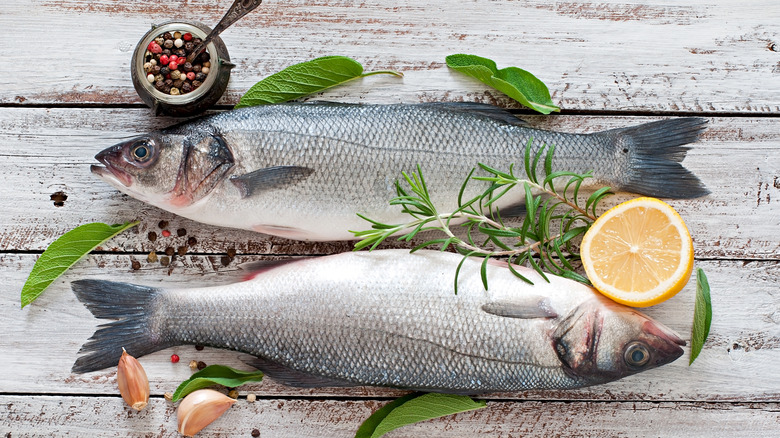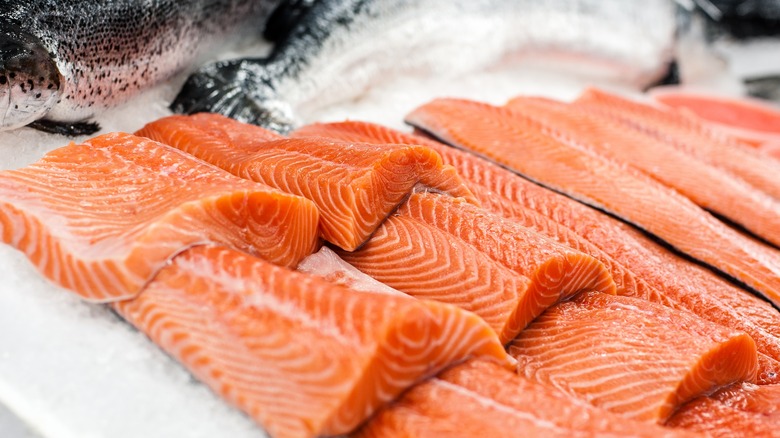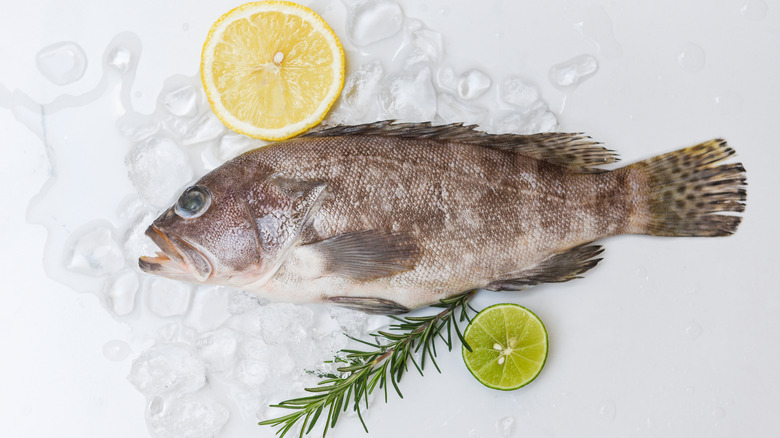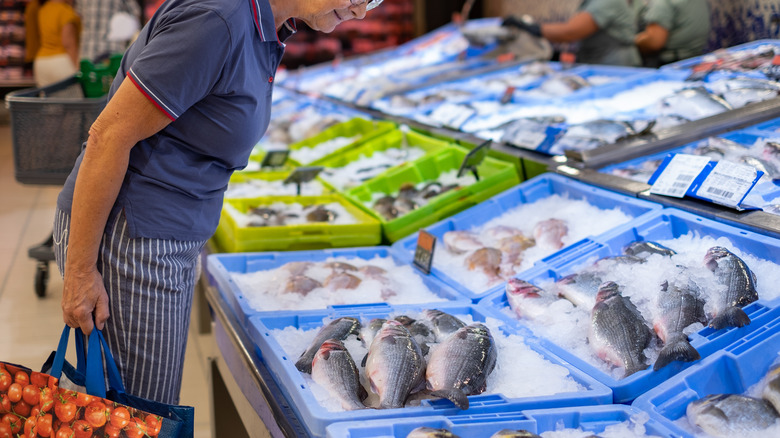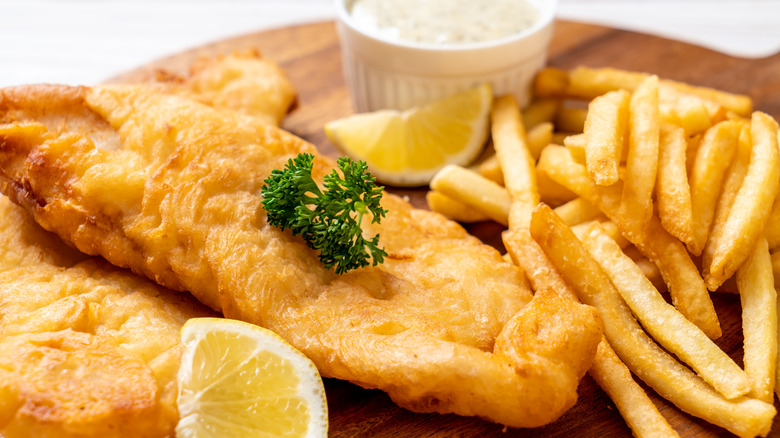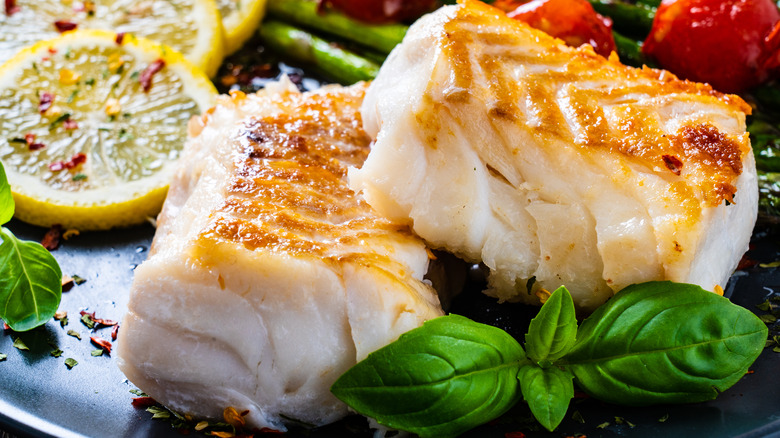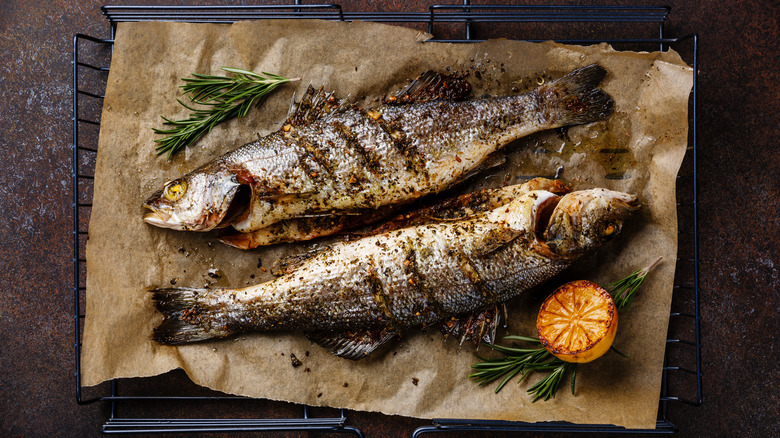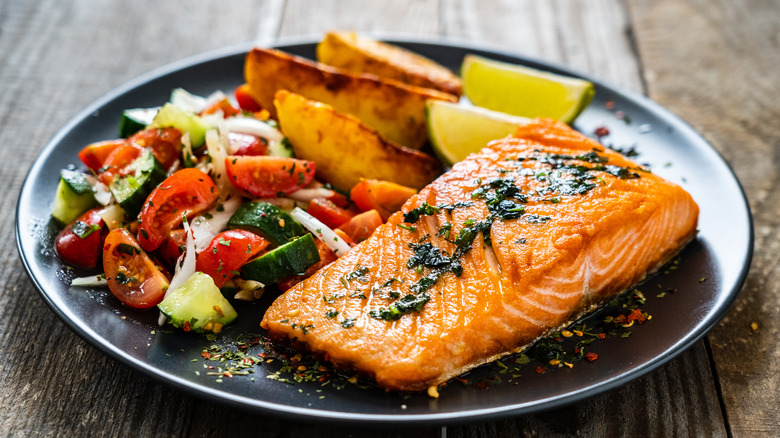A Beginner's Guide To Ordering Fish At A Restaurant
People really love their seafood. In fact, according to Statista, the global seafood market is expected to grow to an estimated $335 billion. If your hard-earned dollars are a part of that estimation, then you owe it to yourself to make sure you are ordering the highest-quality seafood money can buy. That requires a basic knowledge of how ordering fish works. It may seem like it is similar to ordering anything else at a restaurant, but as you will see, there are lots of things to keep in mind. When buying fish to make yourself at home, questions about freshness, the origin of the fish, and price should be taken into account.
Perhaps you have recently taken up fish, or maybe you are traveling to an area where the seafood is more abundant and varied. No matter the reason, if you are newer to ordering fish at restaurants, there are a few key things to keep in mind. Some of these tips will help you familiarize yourself with menu options, while other tips involve engaging in a dialogue with your server to learn more about that particular restaurant's offerings. Before you know it, you will be a seafood pro that knows all the ins and outs of properly ordering fish at restaurants.
Brush up on the fish varieties typically found in restaurants
While the saying claims that "there are plenty of fish in the sea," there are a select few species that tend to be more popular in restaurants than others. These fish tend to be plentiful for fish farming, which makes them more accessible for the food industry to serve on a regular basis. In many restaurants, you can expect to find heartier fish like salmon, in addition to at least one white fish variety.
The common forms of white fish you tend to come across in restaurants include cod, flounder, and sole. Other kinds of fish, like Mahi-mahi, red snapper, and swordfish, are not as common unless you are dining at a seafood-centric restaurant, though you may find them occasionally on a restaurant's daily special menus.
Knowing which kinds of fish you will likely encounter on a restaurant menu will help you when ordering, especially when it comes to your particular appetite or taste palate. You can always head to your local supermarket and try different kinds of fish at home before determining the specific seafood you want to spend money on at restaurants.
Know which varieties of fish are in season
Just like produce, fish is a seasonal food item that tends to follow certain cycles throughout the year based on the mating seasons of each species. Though the fish farming industry has made many kinds of fish readily available year-round, fresh-caught fish are likely going to have ebbs and flows in terms of peak freshness. Depending on where you live or where the restaurant's fish comes from, you may notice that striper or bass are in season come winter, while bluegill or catfish peak over the summer months.
In a Daily Meal interview with David Pilat, global seafood buyer for Whole Foods Market, noted that Red Grouper and Petrale Sole, in particular, are great fish to enjoy in the fall season. But popular favorites like salmon and certain kinds of white fish are likely always going to be in season, thanks to fish farming, or aquaculture, which has grown to be a more sustainable practice over the years.
Ask your server where the fish is sourced from
One easy but important way to learn more about where your local restaurant sources its fish is to strike up a conversation with your server. Restaurant staff should be knowledgeable about where the fish originated from, helping you determine how fresh your dinner truly is. You want to make sure that the fish is either wild-caught or sourced from a fish farm with responsible and sustainable practices.
Another question to ask is when the restaurant gets its fish delivered. Fish is notorious for having a very short shelf life, so you will want to make sure that the restaurant's delivery schedule is as frequent as possible. In most instances, you will find that a restaurant typically receives fish deliveries twice per week based on major fish market schedules. It is often advised by those in the restaurant industry that Sundays and Mondays are the worst days of the week to order fish from a restaurant since that is usually the longest stretch of time between shipments. This means that the fish a restaurant serves on those days has likely been kept for a while, albeit properly stored.
Don't be afraid to ask about fish fraud
If you are new to ordering fish on a regular basis at restaurants, you may be unaware of a practice that is known as fish fraud. It is essentially when someone attempts to pass off an inexpensive fish, say, a common white fish, as something more expensive to sell for a higher profit. The misleading of consumers has led to a crackdown on offenders resulting in fines across the restaurant industry, but it is still something to be aware of when ordering fish.
A 2017 study from UCLA and Loyola Marymount University revealed that nearly half of the sushi available for purchase in Los Angeles was mislabeled. Specifically, species including red snapper, yellowfin tuna, halibut, and yellowtail (species that can usually be sold at a markup) are more likely to be mislabeled. A California restaurant was also fined $120,000 in 2017 for knowingly mislabeling its fish.
Now, this by no means indicates that your local seafood restaurant is committing fish fraud. But by staying educated on the topic and striking up a conversation with your server about where the fish is sourced from, you may be able to avoid being conned into spending more than you really should on your next meal.
Be mindful of allergens
According to the Asthma and Allergy Foundation of America, approximately 6 percent of all adults in the U.S. have some sort of food allergy. These allergies can range in severity from minor irritations to life-threatening reactions that require hospitalization. Because of the wide range of possible allergens and reactions, it is important to be aware of any food allergies in your family before dining out. Restaurants are usually happy to accommodate guests with food allergies and will take every precaution necessary to make sure your party can dine safely.
Fish can cause an allergic reaction in some individuals. There may be even narrower allergens than just seafood, such as crustaceous shellfish, or even as specific as a select few species of fish. If you know that you or someone in your party has seafood allergies, you may want to consider your options before selecting a restaurant or even placing an order for allergy-friendly dining.
Some allergies can be very sensitive; for example, someone with a shellfish allergy may experience a reaction to fried foods like french fries or onion rings if they share the same deep fryer as fried shrimp. The simple smell of fish might also cause discomfort to the person with the allergy, so you may want to rethink that super-smelly fish for dinner.
Be wary of how healthy the dish may or may not be
While many people enjoy seafood for its taste, it can also host several health benefits. This makes fish a popular meal of choice when ordering at a restaurant since dining out can oftentimes come with large portion sizes, added salt, and other processed ingredients. Fish, in general, is a type of food that is high in omega-3 fatty acids, but some fish can carry other benefits as well. Salmon, for example, contains a healthy dose of vitamins and minerals that make it a food many experts recommend you eat on a regular basis.
However, not all fish are created equal, and there are a few things to keep in mind when ordering them at a restaurant. Just because you go for fish and chips, for example, doesn't mean you are reaping all of the benefits. Any fried dish is going to be higher in trans fats, rendering most, if not all, of the potential health benefits of the fish completely null and void. Another thing to be mindful of is the potential for mercury in your fish. Some species, like swordfish and tuna, are going to be higher in mercury and should be eaten less frequently.
Be aware of the different kinds of white fish
Restaurants may sometimes list a fish dish on the menu without specifying what kind of fish is actually included. It may say Fish Tacos on the menu, but it may or may not go into any detail explaining what fish is being used. A simple solution is to ask your server if they know: In general, it will likely be some variety of white fish.
Having a baseline knowledge of the common types of white fish will help you have a general idea of what to expect when ordering it at a restaurant, and it will even help you pair it with side dishes or even wine. Some types of white fish go better with certain dishes than others; for example, lighter fluffier kinds of white fish are best used for a dish like fish tacos. Knowing more about white fish can also help you determine whether a fish is in season or not, which could find out if the fish was wild-caught or not.
Familiarize yourself with seafood-specific cooking terms
There are a lot of tricks and tips to keep in mind when reading a menu. After all, the last thing you want is to feel ripped off because you ordered too much food or you selected something off the menu that you really did not intend on ordering. The same can be said about seafood, where there are a lot of nuances to remember when reading through your list of options.
In addition to considering the type of fish you are ordering, it's also important to keep in mind the method by which the fish is being prepared. Are you ordering a chowder or bisque? Or are you ordering a fish that is being baked, broiled, poached, fried, or grilled? All of these methods will change how the fish tastes, its texture, and whether or not it comes with a number of different sides. A fish taco may be more filling if it comes fried versus grilled, for example.
Oh, another thing you may not want to learn the hard way: If a menu says "whole fish," be prepared to be served a literal whole fish, head and all. It can be a bit of a shock when it comes to your table, and you are not prepared. Also, keep in mind that ordering whole fish dishes will mean that you have more bones to deal with.
Know what to pair with your fish
Like many other entrées at restaurants, ordering fish is likely going to come with a couple of questions. If your fish is served a la carte, you will probably want to pair it with one or two side dishes. It's really up to the diner's choice, but you may not want to overpower the fish with a super-heavy side like a loaded baked potato. Since fish is generally a healthy choice, you can complement it well with any kind of vegetable or rice side dish if you want to keep the meal as low-calorie as possible.
It's also important to consider which alcoholic beverage will pair well with your fish. If you'd like to enjoy a drink with your fish, then in general, wine will pair best with fish. But any low-tannin wine like a white wine, rosé, or a low-tannin red will go well with any white fish. Salmon, on the other hand, may go better with a lighter red wine like pinot noir since the fish itself is richer. If your seafood dish is accompanied by shellfish like oysters, then the occasion could even call for some champagne. Many diners may not notice a strong difference when choosing a drink pairing with their meal, but if that matters to you, it is important to remember that fish will pair a little differently than other meats.
Ask for your preferred level of 'doneness'
When ordering a steak at a restaurant, your server may ask how you would like it cooked. Your answer can range anywhere from rare to well done, which will result in varying levels of 'pinkness' as you slice into your steak. But did you know you can also ask your server about the level of doneness for certain kinds of fish?
In general, white fish will not be served undercooked and will remain on the heat until the entire fish is cooked through. But if you order salmon, you can add if you would like a certain level of doneness. Some people prefer a little bit of that 'pink' in the middle, while others prefer their salmon cooked thoroughly, like a well-done steak. Your server may not ask when you order a salmon, so if you have a preference other than medium, be sure to include that in your order.
Salmon and tuna are two kinds of fish that may also be served rare, depending on the dish that you order. Foods like poke, sushi, and ahi tuna are traditionally served with raw fish, so keep that in mind before ordering if you do not want any raw foods.
